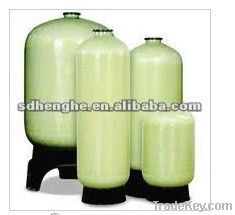

FOB Price
Get Latest Price( Negotiable )
|1 Set Minimum Order
Country:
China
Model No:
PR-dsa329
FOB Price:
( Negotiable ) Get Latest Price
Place of Origin:
Shandong
Price for Minimum Order:
-
Minimum Order Quantity:
1 Set
Packaging Detail:
Non-package, iron or wooden pedestal, suitable for inland or marine transportation
Delivery Time:
20-30days after the contract come into valid
Supplying Ability:
1000 Set per Year
Payment Type:
T/T, L/C
Product Group :
China
Contact Person hou
Zibo, Shandong
Description
FRP (Fibreglass Reinforced Plastics, also known as GRP, or Glass Reinforced Plastics) is a
modern composite material of construction for chemical plant equipment like tanks and vessels.
Chemical equipment that range in size from less than a metre to *0 metres are fabricated using
FRP as material of construction.
FRP Chemical Equipments are manufactured mainly by Hand Lay-up and filament winding processes.
Dual Laminate
Due to the corrosion resistant nature of FRP, the tank can be made entirely from the composite,
or a second liner can be used. In either case, the inner liner is made using different material properties
than the structural portion (Hence the name dual (meaning two) and laminate (a word commonly used
for a layer of a composite material))
The liner, if made of FRP is usually resin rich and utilizes a different type of glass, called "C-Glass", while the structural portion uses "E-Glass". The thermoplastic liner is usually 2.3 mm thick (**0 mils). This thermoplastic liner is not
considered to contribute mechanical strength. The FRP liner is usually cured before winding or
lay-up continues, by using either a BPO/DMA system, or using an MEKP catalyst with cobalt in
the resin.
If the liner is not made of FRP, there are multiple choices for a thermoplastic liner. The engineer
will need to design the tank based on the chemical corrosion requirement of the equipment. PP, PVC,
PTFE, ECTFE,
ETFE, FEP, CPVC, PVDF are used as common thermoplastic liners.
Due to FRP's weakness to buckling, but immense strength against tensile forces and its resistance
to corrosion, a hydrostatic tank is a logical application for the composite. The tank is designed to
withstand the hydrostatic forces required by orienting the fibres in the tangential direction. This
increases the hoop strength, making the tanks anisotropically stronger than steel (pound per pound).
FRP which is constructed over the liner provides the structural strength requirements to withstand
design conditions such as internal pressure or vacuum, hydrostatic loads, seismic loads
(including fluid sloshing), wind loads, regeneration hydrostatic loads, and even snow loads.
Applications
FRP tanks and vessels are widely used in the chemical industry in the following sectors: chlor-alkali manufacturers, fertilizer, wood pulp and paper, metal extraction, refining, electroplating,
brine, vinegar, food processing, and in air pollution control equipment, especially at municipal
| Country: | China |
| Model No: | PR-dsa329 |
| FOB Price: | ( Negotiable ) Get Latest Price |
| Place of Origin: | Shandong |
| Price for Minimum Order: | - |
| Minimum Order Quantity: | 1 Set |
| Packaging Detail: | Non-package, iron or wooden pedestal, suitable for inland or marine transportation |
| Delivery Time: | 20-30days after the contract come into valid |
| Supplying Ability: | 1000 Set per Year |
| Payment Type: | T/T, L/C |
| Product Group : | pressure vessel |